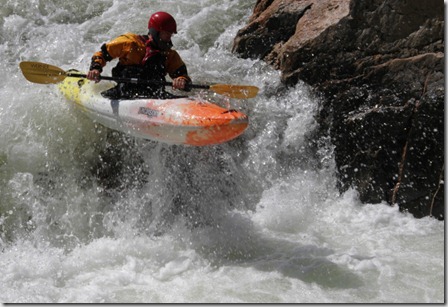 Challenges define who we are in life. Whether they are brought about from unforeseen external circumstances or are conjured in the imagination on a snowy night, challenges take us to places that test our character. And the way we respond to these tests ultimately shapes the people we become. In some circumstances, we succumb to the circumstances and come away feeling like we have lost part of ourselves. But when we make the deliberate choice to rise to the challenges, we grow mentally, emotionally, and physically. This growth is like the branches on a tree that year after year add to the shape and ultimately to the definition of who we are. The very fact that we have shaped our own growth and definition is deeply satisfying and ultimately provides meaning in life.
Challenges define who we are in life. Whether they are brought about from unforeseen external circumstances or are conjured in the imagination on a snowy night, challenges take us to places that test our character. And the way we respond to these tests ultimately shapes the people we become. In some circumstances, we succumb to the circumstances and come away feeling like we have lost part of ourselves. But when we make the deliberate choice to rise to the challenges, we grow mentally, emotionally, and physically. This growth is like the branches on a tree that year after year add to the shape and ultimately to the definition of who we are. The very fact that we have shaped our own growth and definition is deeply satisfying and ultimately provides meaning in life.
As has become an annual tradition for me, I pondered my goals for the year during the snowy nights of the early 2011 calendar and concluded that I would whitewater kayak 100 days in 2011. Considering that I escalated my kayaking efforts the past two years with significant skill improvements and 70 & 82 days on the water, it seemed logical that I should apply myself even more by reaching for the century mark. At the time, the specifics of the goal were not particularly important or well thought out; what mattered was simply that I would be spending more time on the water which would somehow make me a better kayaker. If you have ever heard me talk about what it takes to improve in kayaking, I always say that time on the water is the most critical ingredient and this was my opportunity to see if I was correct. I should say that I was not unique in my claim that more time makes one better at an activity. Every top-notch kayaker I have questioned on the matter has provided the same advice, and books abound with subject matter that purport this theory. Many of my wintery nights were spent reading such books about success and happiness that included: Talent is Overrated, Drive, Outliers, and Don’t Miss Your Life. After spending considerable hours with these books, I decided that I would put their theories to the test with my own little experiment of kayaking 100 days with the hopes that I would somehow learn something new about applying myself towards a challenge.
You might be tempted to think that kayaking 100 out of 365 days in a year is not really all that challenging, since it is barely more than 1 out of every 4 days. If we were talking about jogging or swimming or biking, this would certainly be true. But we aren’t talking about those activities, we are talking about kayaking and I can tell you from my personal experience that it provides an entirely unique set of circumstances that both challenges and rewards the person who chooses to pursue this goal.
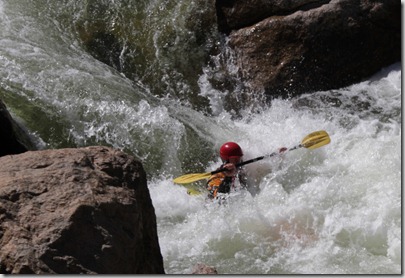 To put things in scientific terms, the two primary differences between kayaking and these other activities concern their availability spacially and temporally. While I could go jogging almost anywhere on the planet (even the oceans are fair ground when you consider cruise ships with tracks around their perimeters) or I could swim at almost any municipal pool, kayak-worthy whitewater rivers are extremely rare in a geographic sense. If you think about it, whitewater rapids require two key ingredients: water in a river and significant gradient that is disturbed by rocks. In terms of land mass, rivers occupy very little space since they are in effect the result of draining water from very large areas of land. So while you are guaranteed to live some place that has lots of land, chances are that you don’t live right next to a river. Additionally, a quick look at a topographic map of the U.S. or the world will reveal that most areas are relatively flat. When you pass a river through a flat area, guess what? No rapids, no whitewater, and therefore, no opportunity for whitewater kayaking. When you convolve the probabilities of having both a river and gradient, you quickly discover that there are very few physical locations where whitewater kayaking is even possible. I have a wonderful wall map in my house that shows all of the whitewater stretches in the state of Colorado and although it excites me every time I examine it, I can tell you that the options are extremely finite.
To put things in scientific terms, the two primary differences between kayaking and these other activities concern their availability spacially and temporally. While I could go jogging almost anywhere on the planet (even the oceans are fair ground when you consider cruise ships with tracks around their perimeters) or I could swim at almost any municipal pool, kayak-worthy whitewater rivers are extremely rare in a geographic sense. If you think about it, whitewater rapids require two key ingredients: water in a river and significant gradient that is disturbed by rocks. In terms of land mass, rivers occupy very little space since they are in effect the result of draining water from very large areas of land. So while you are guaranteed to live some place that has lots of land, chances are that you don’t live right next to a river. Additionally, a quick look at a topographic map of the U.S. or the world will reveal that most areas are relatively flat. When you pass a river through a flat area, guess what? No rapids, no whitewater, and therefore, no opportunity for whitewater kayaking. When you convolve the probabilities of having both a river and gradient, you quickly discover that there are very few physical locations where whitewater kayaking is even possible. I have a wonderful wall map in my house that shows all of the whitewater stretches in the state of Colorado and although it excites me every time I examine it, I can tell you that the options are extremely finite.
Hopefully, I have convinced you that whitewater kayaking is not available in abundance spacially, so back to the temporal aspect. The very fact that rivers flow with any water at all for so much of the year absolutely astounds me. I have an incredibly hard time conceiving of all of the sources of water that ultimately congeal in the form of a creek or river. If you look closely at your local rivers, you will soon discover that the water comes from a source and that source varies considerably based on geographic region. Generally speaking, run-off can be attributed to either rainfall or snow melt, but man-made advancements have caused more and more rivers to be fed by reservoirs that slowly trickle water out at predetermined flow-rates at predetermined times. First, let’s consider the case where your local river is controlled by a dam. Dams need to collect water before they can release it, so most of the time, they are trickling it out in quantities that aren’t sufficient for kayaking and when they do release water, the timing is probably not in sync with your available kayaking days. Next, rain is probably the most obvious source of waters for streams and rivers, but realistically, most locations do not have significant rainfall often enough to support rivers flows that are adequate for kayaking. For instance, the Southeast and the Northeast sections of the U.S. each have distinct time periods when kayaking is “in” due to seasonal precipitation and the rest of the year is essentially “dry”. The second natural source of river water is snowmelt, but snowmelt is even scarcer geographically than rainfall. Fortunately, the same conditions that result in significant snowfields and snowmelt also provide the gradient for the rivers that make excellent whitewater. Given my personal bias and experience, I can not help but talk about Colorado which is a mostly arid climate. However, during the winter months, the unique combination of altitude, dew point, Jetstream and Upslope conditions results in significant snowfall in the vast mountain ranges. Throughout the winter, the mountains do one thing extremely well- they collect snow. Most folks think of this snow and think of skiing and snowboarding, but there is a small contingent of locals who think of something else- whitewater kayaking. The mountains spend from September through May diligently performing this task and then in an absolutely huge rush- WHOOSH!- they let that snow go to melt and to the rivers throughout our incredible state. In what seems like an instant, the rivers go from trickles to raging torrents, but it usually only last for about 2 months out of the entire year. Of course, the timing of these runoffs depends heavily on location, so while one river may be peaking at season-high flows, another may not have even begun to show signs of runoff. In any case, the result of the snowmelt-fed rivers is that there is an extremely limited duration of worthy kayaking and that it is spread unevenly in time and in extremely specific locations. No matter how you look at it, rivers just don’t produce quality whitewater for much time in most locations.
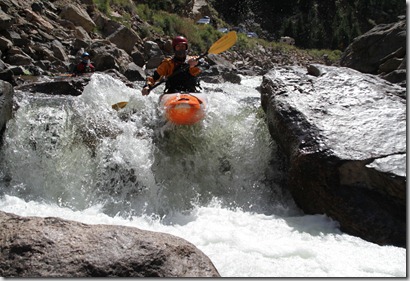 Now, let’s get back to the point. Let’s consider the individual (me!) who wants to kayak 100 days in a calendar year. First off, rivers within any reasonably close geographic region are not even flowing except for about 1/3 of the year. So now we have gone from kayaking 100/365 days to 100/122 days. Oops, I guess I should have considered that before committing to this undertaking. That is equivalent to more than 80% of the time or close to 6 out of 7 days of the week. Any sane athlete will tell you that training 6/7 days per week is a bad idea- it is called overtraining. Simply put, the human body can not keep up if you want to maintain optimal performance.
Now, let’s get back to the point. Let’s consider the individual (me!) who wants to kayak 100 days in a calendar year. First off, rivers within any reasonably close geographic region are not even flowing except for about 1/3 of the year. So now we have gone from kayaking 100/365 days to 100/122 days. Oops, I guess I should have considered that before committing to this undertaking. That is equivalent to more than 80% of the time or close to 6 out of 7 days of the week. Any sane athlete will tell you that training 6/7 days per week is a bad idea- it is called overtraining. Simply put, the human body can not keep up if you want to maintain optimal performance.
Now I am going to throw in another constraint on this kayaking challenge, and I think it is a pretty important point. If I were a professional kayaker who could devote most of his time to this endeavor, 100 days would actually be a let down. Or if I were coasting through my 20’s without a steady job or home, it could be a cake-walk. But that is not the situation that I signed up for in January of 2011. I am a professional aerospace engineer who has 4 weeks of vacation per year and I am required to be in the office Monday through Friday the rest of the weeks. Furthermore, I live and work in Boulder, CO which is incredible, but it is not a location with a major river corridor. Once again, THIS is my situation and THIS is my challenge, so simply saying 100 days in a year is not sufficient to explain the situation.
Now let’s go through a little exercise together. I am going to assume that flows are extremely good in Colorado for two months of the year in the areas close enough to kayak every single day of the week. So theoretically, I could kayak 60/60 days and reach 60% of my goal. Realistically, let’s say that for one reason or another, I “only” kayak 6 of 7 days per week during those 2 months, so I achieve 51 days during the peak run-off and still have 49 days to kayak the rest of the year. Now remember, for the rest of the year, there is no kayaking close enough to do after work which means that the 49 remaining days have to take place on weekends (Sat/Sun) which equates to 24.5 weekends of nothing but kayaking. Of course, those 24.5 weekends take place during the remaining 10 months of the year, which means that for 6 of the remaining 10 months of the year, I need to kayak both Saturday and Sunday every single weekend! Now let’s be a little more conservative and say that I only kayak 3 of every 4 weekends. That means that I need to kayak almost every weekend for the 8 out of 10 months that I am not kayaking 6 out 7 days of the week! And of course, this is Colorado we are talking about, so at least 4 months of the year are extremely cold, snowy, and without water in the rivers. When you start to put it in these terms, this goal begins to sound crazy, but now I am going to convince you that it is actually much, much crazier.
 My kayaking year started out strong due to a secondary goal to kayak at least once every month of the year, but once I started to get into the thick of it, I began to realize that I may have bit off more than I could chew. I knew that I would have the mental fortitude to put in 6/7 days during peak run off, but the fact is that the human body can only take so much. There was a stretch when I kayaked for 13 days straight and realized that I simply could not sustain that level of effort. One of the important things to remember about whitewater kayaking is that it is not only a physically demanding activity, it is also a potentially deadly activity. What that means is that it is irresponsible and dangerous to participate when you physically are not able and after weeks of continuous kayaking, you reach the point that you simply are not able. Put another way, simply reaching the 6/7 days per week for 2 months was actually a worthy goal from just from a physical standpoint. Despite the fact that I felt guilty for not being on the water, at some point I instituted a policy with myself that I had to take a day off about once per week.
My kayaking year started out strong due to a secondary goal to kayak at least once every month of the year, but once I started to get into the thick of it, I began to realize that I may have bit off more than I could chew. I knew that I would have the mental fortitude to put in 6/7 days during peak run off, but the fact is that the human body can only take so much. There was a stretch when I kayaked for 13 days straight and realized that I simply could not sustain that level of effort. One of the important things to remember about whitewater kayaking is that it is not only a physically demanding activity, it is also a potentially deadly activity. What that means is that it is irresponsible and dangerous to participate when you physically are not able and after weeks of continuous kayaking, you reach the point that you simply are not able. Put another way, simply reaching the 6/7 days per week for 2 months was actually a worthy goal from just from a physical standpoint. Despite the fact that I felt guilty for not being on the water, at some point I instituted a policy with myself that I had to take a day off about once per week.
It is probably obvious that whitewater kayaking is demanding in a physical sense. After all, you push yourself to the limits in raging whitewater that most people would never consider approaching. On top of that, I would consider myself a fairly aggressive paddler which means that I am disappointed if I don’t get off the water feeling like I got a good workout. However, there is actually quite a bit more about kayaking that leads to physical exhaustion. If we return to my earlier point about the geographic scarcity of whitewater kayaking locations, you see that quite a bit of travel is involved simply to reach the rivers in question. Most local, after-work rivers require about 30-45 minutes of driving one-way, while most weekend destinations are 2-3 hours away. And once you reach the river, the driving isn’t over. People often wonder how we kayak down the rivers, end up in new location, and then somehow magically return to our cars. Well, the answer is the shuttle. Basically, we drive cars back and forth from the put-in to the take-out to ensure that we can get our gear and ourselves back and forth. The shuttle is never really fun. It is time consuming (20 minutes up to several hours) and almost always complicated. And when you add its time to the drive to the river, you can typically count on the fact that you spent more time driving than you did kayaking on the river! All of this driving time plus all of the river times adds up to extremely little time at home. For instance, I typically get up in the morning, go to work, drive directly to a river after work, kayak, and then finally return home around 10-11pm. And this is for more than 2 months straight, so you can imagine that it imparts a significant physical toll that is in addition to the physical stress that kayaking itself imparts.
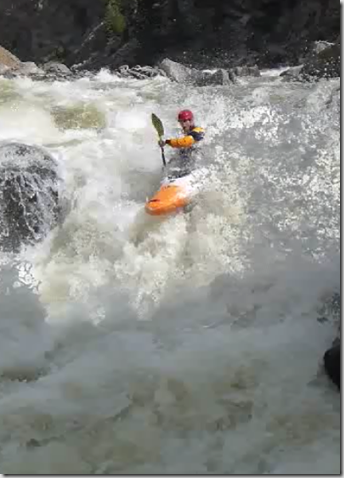 Now let’s begin to talk about the logistical aspects that only add to the stress and exhaustion while greatly striving to reduce the chances of making it onto the water. If you have ever put your life on hold for a little while, you know how frustrating it is to not deal with all of the little things in life that take time- grocery shopping, laundry, cleaning, bills, etc. All of these little things seem to have one purpose during kayaking season- to keep you from kayaking every day. Assuming that you have figured out all of your personal and professional logistics, you still aren’t in the clear to kayak every day, because it is one of the rare activities that requires partners to perform safely. So each and every day, you send emails, text messages, voicemails, and Facebook posts to your paddling buddies to convince them to come paddling with you because, “Dude, the water is totally awesome today and we aren’t going to have this opportunity next week. It’s going to be awesome! 2011 is going to go down in the record books and you don’t want to regret missing out on it, right?” The very act of finding and coordinating with paddling partners adds an additional level of effort to every day on the water. And of course, I am describing what it is like to find boating partners during the good times of the year and not when it is snowing out and most folks are out skiing. Unlike jogging or swimming, you can’t simply just go out and do it by yourself for an hour in your neighborhood. Oh no, you had better be prepared and committed, because this is kayaking we are talking about.
Now let’s begin to talk about the logistical aspects that only add to the stress and exhaustion while greatly striving to reduce the chances of making it onto the water. If you have ever put your life on hold for a little while, you know how frustrating it is to not deal with all of the little things in life that take time- grocery shopping, laundry, cleaning, bills, etc. All of these little things seem to have one purpose during kayaking season- to keep you from kayaking every day. Assuming that you have figured out all of your personal and professional logistics, you still aren’t in the clear to kayak every day, because it is one of the rare activities that requires partners to perform safely. So each and every day, you send emails, text messages, voicemails, and Facebook posts to your paddling buddies to convince them to come paddling with you because, “Dude, the water is totally awesome today and we aren’t going to have this opportunity next week. It’s going to be awesome! 2011 is going to go down in the record books and you don’t want to regret missing out on it, right?” The very act of finding and coordinating with paddling partners adds an additional level of effort to every day on the water. And of course, I am describing what it is like to find boating partners during the good times of the year and not when it is snowing out and most folks are out skiing. Unlike jogging or swimming, you can’t simply just go out and do it by yourself for an hour in your neighborhood. Oh no, you had better be prepared and committed, because this is kayaking we are talking about.
At this point, I may have convinced you that kayaking 100 days in a year is extremely challenging, but I probably also left you wondering why I would possibly endure such hassles for an arbitrary goal. Well, the first answer I can provide is the simplest and possibly the least satisfying- I said that I was going to do it, so I had to do it. Among all of the books I read over the winter, there was a common theme of intrinsic motivation– doing something simply for its own sake. I suppose that I have always been an intrinsically motivated individual, but after reading so much about the topic, I was even more interested in applying it in my life and this was a great reason to do so. But there were dozen of additional reasons why this goal was so attractive and they usually were the flip sides of the challenges.
For instance, finding boating partners can be difficult, but the friendships that are formed on the water are priceless. We not only share a love for the water, but we also protect each other every time we run a river. When you trust other people with your own safety and life, a bond forms that is rare in day-to-day life. On a less dramatic note, I would also like to think that my incessant desire to kayak may have somehow inspired some of my friends to be on the water when they would not have been otherwise. And when I couldn’t always round up the usual suspects, I found new friends to share the experience with. I think that we spend much of our life attempting to connect with other people, and my first hand experience with kayaking has provided some of my most rewarding connections with others. For that alone, the 100 days was worth it.
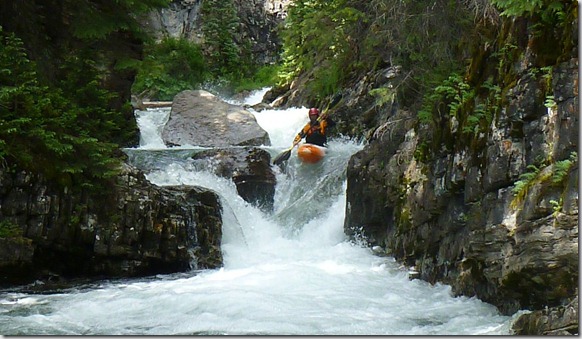 For all of the fatigue and exhaustion, there was the obvious corollary benefit- physical fitness. People spend inordinate amounts of time in pursuit of physical fitness in sterile gyms that provide almost no reward mentally or emotionally. In contrast, kayaking is an amazing workout that fully stimulates the senses, engages the mind, and gratifies the soul. If I had to commit to 100 days of exercise in a year, I can’t imagine a more satisfying activity than whitewater kayaking. There was also a second, more subtle benefit to the prolonged exercise- efficiency. At some point, I realized that I simply could not commit myself physically, mentally, and emotionally at the same sustained, high level, so I began to engage in efficient behaviors that allowed me to continue at a lower level of effort. Learning to be efficient at an activity reveals so many nuances that only further enhance the original intent of the activity.
For all of the fatigue and exhaustion, there was the obvious corollary benefit- physical fitness. People spend inordinate amounts of time in pursuit of physical fitness in sterile gyms that provide almost no reward mentally or emotionally. In contrast, kayaking is an amazing workout that fully stimulates the senses, engages the mind, and gratifies the soul. If I had to commit to 100 days of exercise in a year, I can’t imagine a more satisfying activity than whitewater kayaking. There was also a second, more subtle benefit to the prolonged exercise- efficiency. At some point, I realized that I simply could not commit myself physically, mentally, and emotionally at the same sustained, high level, so I began to engage in efficient behaviors that allowed me to continue at a lower level of effort. Learning to be efficient at an activity reveals so many nuances that only further enhance the original intent of the activity.
Let me tell you, 100 days is a lot of days kayaking. And with all of those days, I began to notice two more benefits that had to do with deliberate practice. There are two main challenges to overcome when practicing a skill- internal conditions and external conditions. For instance, swimmers benefit from pools that are of the same temperature, the same length, in the same location, etc. This allows them to focus on their internal challenges that have to do with their stroke technique and their conditioning. For the most part, the external conditions are kept static to allow internal growth. This is wonderful assuming that the external conditions do not change. But if a swimmer were to attempt the English Channel following only pool workouts, chances are that they would struggle to perform since they did not practice under those conditions. The internal conditions associated with kayaking are formidable, as anyone who has “lost” their roll can attest to. It is not only the skills that are challenging, but maintaining the proper mental and emotional state of mind can be extremely daunting. When kayaking, almost every day presents its own set of circumstances and difficulties that must be addressed. The river flows change constantly, there are different rivers to kayak almost every weekend, the weather has a profound effect, and even the rapids themselves change character with time. With so many internal and external variables, the conditions do not look favorable to make steady, measured progress. However, if you spend an extended, successive time on the water, two things happen that make progress much easier. For one thing, external conditions change much less on a day-to-day basis versus week-to-week or month-to-month. All of a sudden, it becomes possible to run the same stretch of river at the same flow with the same river on multiple occasions in a few days, and when that happens, the only thing that changes and that correspondingly makes progress are the internal conditions. In other words, by kayaking on a very frequent basis, it is possible to focus on the internal skills (strokes, rolling, etc.) without having to worry about running a new river at new flows. On the other hand, the variability of flows, rivers, and weather also contributes towards growth, since they force the paddler to adapt to the varying conditions. The adaptation stretches the skills that were honed under controlled circumstances to new levels ultimately resulting in growth.
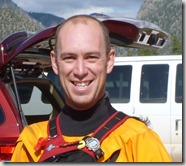 Finally, I discovered that one of the primary reasons for the 100 day kayaking goal was to step into the unknown. I didn’t need to think through all of these possibilities before engaging in this pursuit, but I knew that I would encounter, begin to understand, and deal with each of them. It was much like running a river itself- ultimately, it was about putting myself in the situation and figuring out how I was going to respond to the challenge. It was not even necessarily all of the kayaking that mattered so much in the end. In fact, it was the act of deliberately defining a goal, and then actively pursuing it to its end that made this accomplishment so deeply satisfying.
Finally, I discovered that one of the primary reasons for the 100 day kayaking goal was to step into the unknown. I didn’t need to think through all of these possibilities before engaging in this pursuit, but I knew that I would encounter, begin to understand, and deal with each of them. It was much like running a river itself- ultimately, it was about putting myself in the situation and figuring out how I was going to respond to the challenge. It was not even necessarily all of the kayaking that mattered so much in the end. In fact, it was the act of deliberately defining a goal, and then actively pursuing it to its end that made this accomplishment so deeply satisfying.

[…] as the 7 Habits spoke of, I realize that it is only possible for me to do this now because of the significant personal development that I invested in myself with kayaking the past several […]